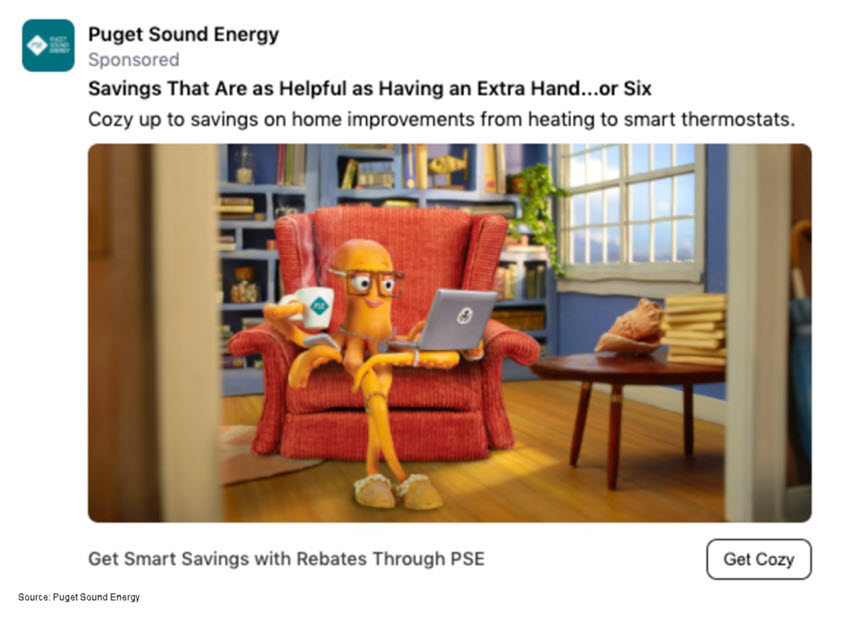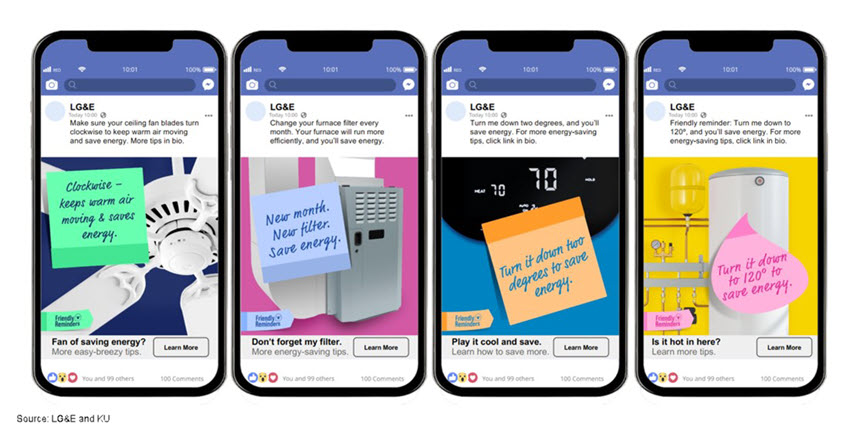Contents
Offer relatable and realistic tips
Proactively plan your campaigns
Consider a campaign’s timing
Learn from other utilities
Utilities want to promote ways for customers to lower their energy bills, whether they’re heating in the winter or cooling in the summer. But not all solutions will work for every customer, and some energy-saving tips are more expensive and time-consuming to adopt than others.
When figuring out how to deliver energy-saving tips, look at your customer segments by age, income, energy type, location, housing status, and which utility energy efficiency programs they’re already participating in. This will help your communications team design key messages, connect with target audiences, choose communication channels, and time your messages’ delivery.
Offer relatable and realistic tips
Take time to understand why different customers might want to adopt seasonal measures to save energy and lower their bills. When you understand your customers’ biggest challenges, you can help them by offering relatable and realistic tips. Be empathetic toward customers’ unique situations and try to meet them where they are.
There are many factors that can affect what tips are most useful for customers. Your utility can start by considering customer income and location.
Consider customer income
A customer who has a fixed income may be more interested in energy-saving tips that have a low up-front cost and are easy adopt. In comparison, a customer who has a flexible monthly budget or owns their home might be more likely to use tips that have a high up-front cost but will help them save energy and money in the long run.
Advice for low- and moderate-income (LMI) customers. Advising customers to better insulate their homes is useful advice. But an LMI customer may not be able to add more insulation in their home because they rent their property or don’t have the budget.
When choosing what tips to offer these customers, focus on tips that are more universal for renters and homeowners such as:
- Closing curtains during the warmest parts of the day
- Reducing the workload on their AC unit
- Avoiding doing tasks like laundry or running the dishwasher during peak times
Advice for high-income customers. Customers with more flexible budgets may be able to afford purchases that come with a higher price tag—like upgrading to ENERGY STAR doors and windows.
When connecting with these customers, consider promoting utility-offered products or programs in addition to general energy-saving tips. Your team can also highlight the benefits outside cost savings such as the environmental impact of their changes.
Consider customer location
Depending on where your customers are located, certain times of the year may be more fitting for messaging. In colder climates, you can share ways to keep the heat in and effectively use heating equipment and ventilation. In warmer climates, it’s important to share ways to keep the heat out and effectively use AC and ventilation.
For example, May to August might be the best time to promote cooling tips in the Southwest. But this isn’t as true in places like New England and other cooler climates. From September to April, messaging from Minnesota gas providers may focus on energy tips for heating the home. But in Florida, electric utilities may be messaging about using fans to move cool air around the house.
To learn more about promoting different energy-saving tips during different seasons, check out How can residential customers lower their winter heating bills? and What energy-saving tips can help residential customers lower summer bills?
Proactively plan your campaigns
Seasons are predictable, so your team can prepare messaging ahead of time. In your campaign and messaging plans, include:
- Goals and metrics
- Risks and benefits
- Target audiences
- Key messages for each audience group
It’s also important to decide what channels you’ll use to reach each group and understand what type of messaging connects with customers on each channel.
Use social media effectively
Social media can help your utility reach a large audience, but some messaging is more effective than others. According to findings from the E Source 2023 Social Media Survey, most utilities had only moderate success when it came to connecting customers with energy efficiency programs through platforms such as Facebook, X, YouTube and LinkedIn.
Overall, social media channels were more effective for communicating about outages and emergencies or addressing customer service issues. While social media should be part of your plan when promoting energy-saving tips, it shouldn’t be the only channel you’re using.
Make emails part of campaigns
The E Source US Residential Customer Insights Center compiles data from the Claritas Energy Behavior Track annual online survey of about 32,000 residential customers in the US (conducted in partnership with E Source). Utilities rely on this tool to understand their residential customers’ behaviors and attitudes around energy consumption
According to 2023 data, US residential respondents prefer their energy efficiency messaging to come from their electric utility via:
- Email—54%
- Postal mail—22%
- Text message—21%
The E Source Business Customer Insights Center uses information from the E Source Business Customer Satisfaction Study to offer insights about the energy management needs and attitudes of specific business sectors. According to 2023 data, US business respondents prefer regular contact from their utility via:
- Email—60%
- Over the phone—18%
- Text message—6%
Invest in and use emails as a primary channel for promoting energy-saving tips to your residential and business customers.
Consider a campaign’s timing
Promote different energy-saving tips throughout the year. This can help customers stay motivated and maximize the benefits before, during, and after the season.
Before the season
The earlier utilities start to send seasonal messaging, the better. Take advantage of the spring and fall “shoulders” to prime your audience on ways to be more energy conscious while staying comfortable. Sending seasonal messaging before the season starts can also raise awareness about evergreen energy efficiency program offerings. You want to emphasize that the best time to adopt energy efficiency tips is before customers face high energy bills.
One way to do this is by explaining the different terms you’re going to use in the energy-saving tips. For example, before you promote weatherstripping as an energy-saving tip in the winter, use your messaging in the fall to explain:
- What weatherstripping is
- How it works for customers
- What offerings or programs customers can take advantage of
You also want to use preseason messaging to promote efficiency measures that take longer to set up, like swapping out old windows for insulated ones.
During the season
Savings and comfort will be top of mind when customers are experiencing hot summers and cold winters. During the season, share easy-to-adopt energy efficiency tips such as ensuring window blinds are closed or checking door seals to keep cold air from getting inside. Make the positive and immediate impacts of adopting these solutions part of key messages.
After the season
The end of the season is a suitable time to tell your customers how to prepare for next year because the impacts of the season are still fresh in their minds. One way to do this is to reintroduce customers to programs and technologies—like smart thermostats—that can help them save money on future bills.
If your utility has a marketplace, this is a suitable time to promote it to customers. Consider also offering postseason discounts or highlighting available incentives. Check out the report Online marketplace marketing strategies for more tips.
Learn from other utilities
Nobody knows utility customers better than utilities. When planning your seasonal messaging, think about campaigns that worked well. Did they hit an emotional note or a humorous one? How did they present the facts?
E Source Energy AdVision is our database of thousands of examples of utility marketing and advertising campaigns. We populate this database with ads submitted to the annual E Source Utility Ad Awards. These submissions include information such as:
- Campaign background and goals
- Strategy and tactics
- Timeline
- Target market
- Results
Below, we’ve highlighted effective seasonal messaging examples from utilities across the US and Canada.
As part of the PG&E’s Home Energy Checkup Winter Email campaign, PG&E urged customers to complete a Home Energy Checkup before the winter season. The email:
- Showed customer how much of their bill went to heating the year before
- Encouraged customers to better understand their energy usage
- Offered actionable tips that didn’t require customers to visit the utility’s website
The campaign resulted in 20,500 new recorded completions—12.5 times the number from the year before.
PG&E uses email to connect with residential customers
Winter in the Northwest US is typically cold and wet. Puget Sound Energy (PSE) launched its PSE Energy Efficiency Cozy campaign to deliver efficiency messaging and promote rebates for:
- Space heat
- Water heat
- Smart thermostat
PSE used a multichannel approach, resulting in 4.1 million impressions and 5,300 clicks to the website.
PSE’s digital campaign features cozy creatures and offers energy-saving tips
Alliant Energy used a direct mail postcard as part of its Small Business Energy Assessments program. To create leads going into the new year, Alliant Energy offered a free energy assessment to small businesses on its mailing list.
The utility reported that 542 businesses responded, resulting in 497 energy efficiency projects through March 2019. These assessments accounted for 40% of Alliant Energy’s annual energy assessment goal.
Alliant Energy invites small business customers to save
LG&E and KU’s Energy Efficiency Friendly Reminders campaign shares easy ways to save energy and money. The utility offered tips customers could use across multiple seasons.
The campaign generated over 30 million impressions across digital and traditional media. It also resulted in 17,000 new visitors to the utility’s energy efficiency tips landing page.




